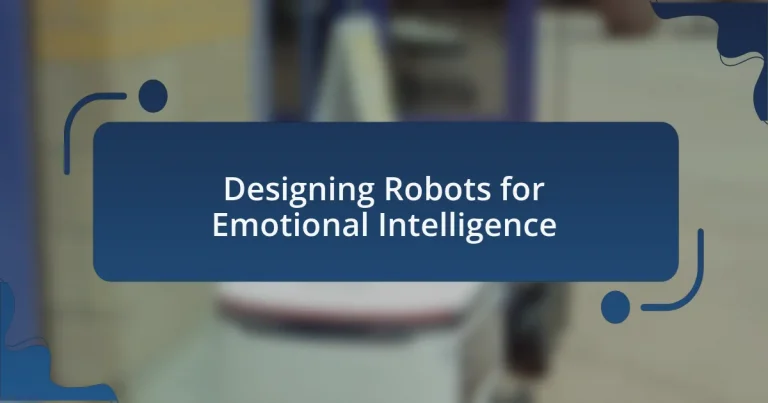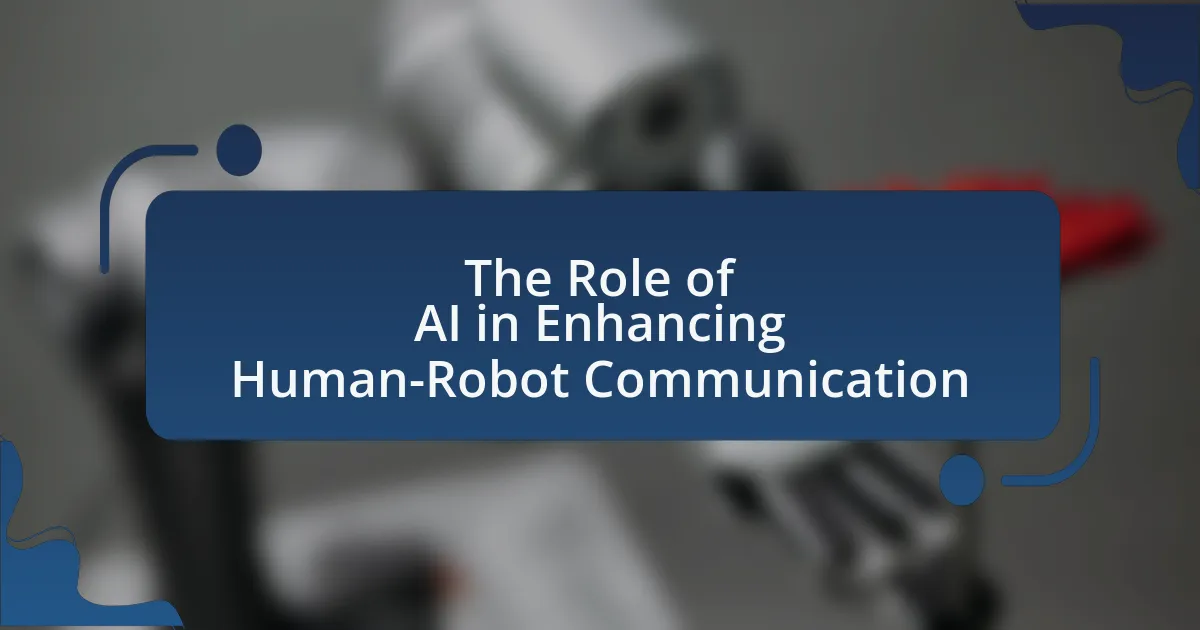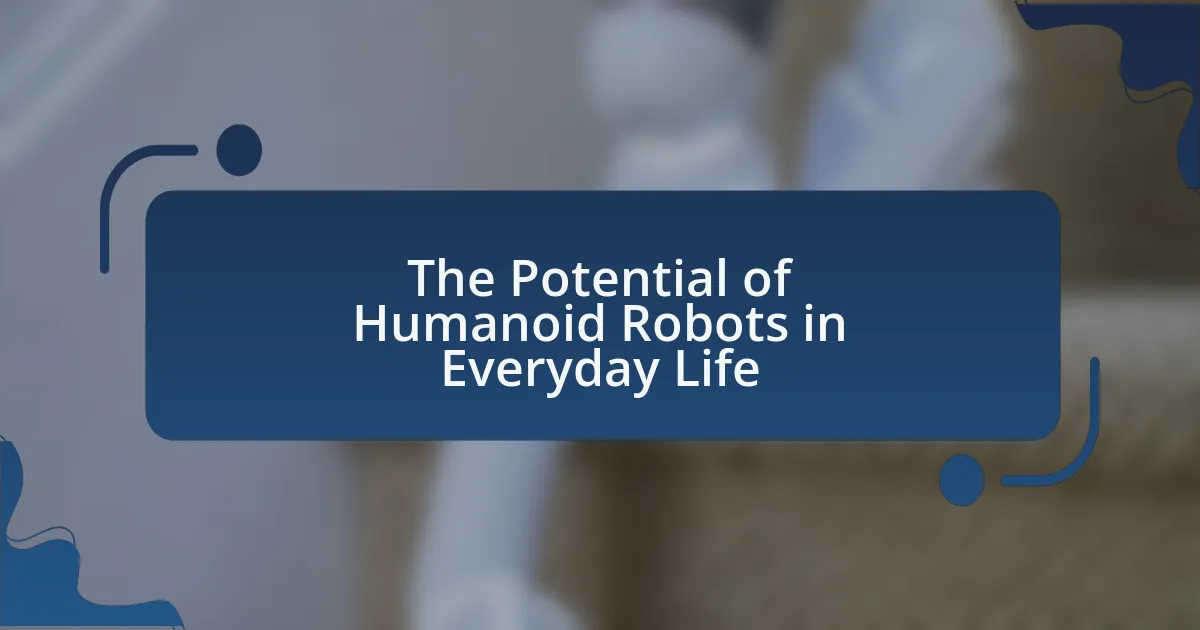Designing robots for emotional intelligence focuses on creating machines capable of recognizing, interpreting, and responding to human emotions. This interdisciplinary approach combines artificial intelligence, psychology, and robotics to enhance human-robot interactions across various applications, including healthcare, education, and customer service. Key components of emotional intelligence in robots include emotional perception, understanding, regulation, and expression, which are measured through affective computing techniques and user feedback. The article also addresses the challenges and ethical considerations in developing emotionally intelligent robots, emphasizing the importance of user-centered design and interdisciplinary collaboration to improve functionality and user experience. Successful examples of emotionally intelligent robots, such as Sophia and Paro, illustrate their impact on enhancing emotional support and engagement in their respective fields.

What is Designing Robots for Emotional Intelligence?
Designing robots for emotional intelligence involves creating machines that can recognize, interpret, and respond to human emotions effectively. This process integrates fields such as artificial intelligence, psychology, and robotics to enable robots to engage in empathetic interactions. For instance, research has shown that robots equipped with emotional recognition algorithms can analyze facial expressions and vocal tones to gauge emotional states, enhancing user experience in applications like therapy and customer service.
How do emotional intelligence and robotics intersect?
Emotional intelligence and robotics intersect through the development of robots that can recognize, interpret, and respond to human emotions. This intersection is crucial for creating social robots that can engage effectively with humans, enhancing user experience in applications such as healthcare, education, and customer service. Research indicates that robots equipped with emotional intelligence capabilities can improve communication and empathy, leading to better interactions; for instance, studies have shown that robots like SoftBank’s Pepper can read facial expressions and adjust their behavior accordingly, demonstrating a practical application of emotional intelligence in robotics.
What are the key components of emotional intelligence in robots?
The key components of emotional intelligence in robots include emotional perception, emotional understanding, emotional regulation, and emotional expression. Emotional perception allows robots to recognize and interpret human emotions through cues such as facial expressions, tone of voice, and body language. Emotional understanding enables robots to comprehend the context and significance of these emotions, facilitating appropriate responses. Emotional regulation equips robots to manage their own emotional responses and adapt their behavior accordingly, ensuring interactions remain constructive. Finally, emotional expression allows robots to convey emotions effectively, enhancing their ability to engage with humans empathetically. These components are essential for robots to interact meaningfully and supportively with people, as evidenced by advancements in affective computing and human-robot interaction studies.
How is emotional intelligence measured in robotic systems?
Emotional intelligence in robotic systems is measured through a combination of affective computing techniques, behavioral analysis, and user interaction feedback. Affective computing involves the use of sensors and algorithms to detect and interpret human emotions based on facial expressions, voice tone, and physiological signals. Behavioral analysis assesses how robots respond to emotional cues in real-time, adapting their actions to align with the emotional state of users. User interaction feedback is gathered through surveys and observational studies, evaluating how effectively robots can recognize and respond to emotional needs. Research has shown that these methods can quantify emotional intelligence by analyzing the accuracy of emotion recognition and the appropriateness of responses, thereby validating the effectiveness of emotional intelligence in robotic systems.
Why is emotional intelligence important in robotics?
Emotional intelligence is important in robotics because it enables robots to understand and respond to human emotions, enhancing human-robot interaction. This capability allows robots to provide more effective support in various applications, such as healthcare, education, and customer service. Research indicates that robots equipped with emotional intelligence can improve user satisfaction and engagement, as they can adapt their behavior based on emotional cues. For instance, a study published in the journal “Science Robotics” demonstrated that emotionally aware robots could better assist individuals with mental health issues by recognizing signs of distress and responding appropriately.
What benefits does emotional intelligence bring to human-robot interaction?
Emotional intelligence enhances human-robot interaction by enabling robots to understand and respond to human emotions effectively. This capability fosters improved communication, as emotionally intelligent robots can interpret non-verbal cues and adjust their behavior accordingly, leading to more natural and engaging interactions. Research indicates that robots equipped with emotional intelligence can increase user satisfaction and trust, as they are perceived as more relatable and empathetic. For instance, a study published in the journal “Frontiers in Robotics and AI” by authors A. K. Dautenhahn and K. L. MacDorman demonstrates that emotionally aware robots can significantly improve user experience in caregiving and educational settings.
How does emotional intelligence enhance robot functionality in various applications?
Emotional intelligence enhances robot functionality by enabling them to recognize, interpret, and respond to human emotions effectively. This capability allows robots to engage in more meaningful interactions, improving user experience in applications such as healthcare, education, and customer service. For instance, robots equipped with emotional intelligence can adapt their responses based on the emotional state of users, leading to increased empathy and support in therapeutic settings. Research indicates that emotionally intelligent robots can improve patient outcomes by providing companionship and emotional support, as demonstrated in studies involving social robots in elderly care.
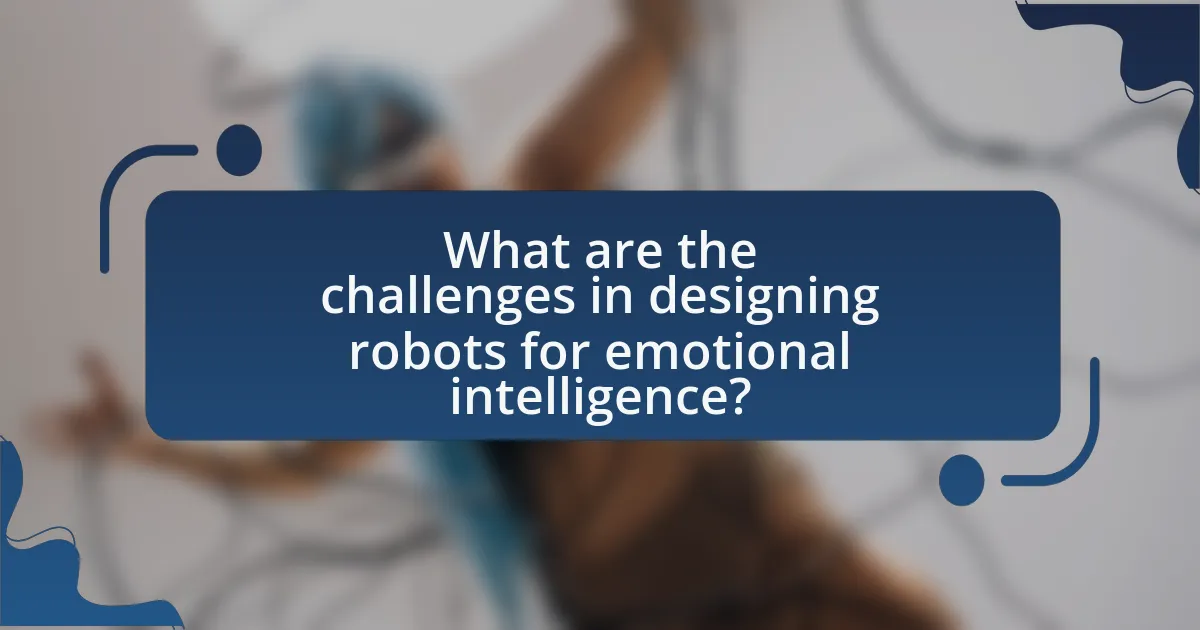
What are the challenges in designing robots for emotional intelligence?
Designing robots for emotional intelligence faces several challenges, primarily in accurately recognizing and interpreting human emotions. One significant challenge is the complexity of human emotional expression, which varies widely across cultures and individuals, making it difficult for robots to consistently identify emotions through facial expressions, tone of voice, and body language. Additionally, the integration of natural language processing with emotional context is complex, as robots must understand not only the words spoken but also the emotional undertones behind them. Furthermore, ethical considerations arise in ensuring that robots do not manipulate human emotions or invade privacy, which complicates design choices. These challenges highlight the need for advanced algorithms and interdisciplinary approaches to effectively equip robots with emotional intelligence capabilities.
What technical hurdles must be overcome?
To design robots for emotional intelligence, developers must overcome several technical hurdles, including the accurate recognition of human emotions, the ability to respond appropriately to those emotions, and the integration of complex algorithms for emotional processing. Accurate emotion recognition requires advanced sensors and machine learning models capable of interpreting facial expressions, vocal tones, and body language, which are inherently nuanced and context-dependent. Additionally, robots must be programmed with sophisticated response mechanisms that allow them to engage empathetically, which involves understanding context and adapting behavior in real-time. Finally, the integration of these systems into a cohesive framework presents challenges in computational efficiency and reliability, as robots must operate seamlessly in dynamic environments.
How do data processing and machine learning impact emotional intelligence in robots?
Data processing and machine learning significantly enhance emotional intelligence in robots by enabling them to analyze and interpret human emotions accurately. Through advanced algorithms, robots can process vast amounts of data from various sources, such as facial expressions, voice tone, and body language, allowing them to recognize emotional cues. For instance, a study by Picard et al. (2018) demonstrated that robots equipped with machine learning models could achieve over 80% accuracy in emotion recognition tasks. This capability allows robots to respond appropriately to human emotions, fostering more natural and effective interactions. Thus, the integration of data processing and machine learning is crucial for developing robots that can understand and engage with human emotional states effectively.
What role does sensor technology play in emotional intelligence design?
Sensor technology is crucial in emotional intelligence design as it enables robots to perceive and interpret human emotions through various data inputs. By utilizing sensors such as cameras, microphones, and biometric devices, robots can analyze facial expressions, vocal tones, and physiological signals, allowing them to respond appropriately to human emotional states. For instance, research indicates that facial recognition technology can achieve over 90% accuracy in identifying emotions, demonstrating the effectiveness of sensor integration in enhancing emotional responsiveness in robots. This capability not only improves human-robot interaction but also fosters empathetic responses, making robots more effective in roles that require emotional engagement, such as caregiving or customer service.
What ethical considerations arise in this field?
Ethical considerations in designing robots for emotional intelligence include issues of privacy, autonomy, and the potential for manipulation. Privacy concerns arise as these robots may collect and analyze personal emotional data, leading to unauthorized surveillance or data breaches. Autonomy is challenged when robots influence human emotions or decisions, raising questions about consent and the extent of their impact on human agency. Additionally, the potential for manipulation exists, as emotionally intelligent robots could exploit vulnerabilities in human emotions for commercial or political gain. These considerations highlight the need for ethical guidelines and regulations to ensure responsible development and deployment of emotionally intelligent robots.
How can we ensure robots respect human emotions and privacy?
To ensure robots respect human emotions and privacy, developers must integrate ethical guidelines and emotional intelligence frameworks into their design. This involves programming robots to recognize and appropriately respond to human emotional cues, such as facial expressions and tone of voice, which can be achieved through advanced machine learning algorithms. Additionally, implementing strict data privacy protocols, such as anonymizing user data and obtaining explicit consent for data collection, is essential. Research indicates that robots equipped with emotional recognition capabilities can enhance user experience while maintaining privacy, as seen in studies like “The Role of Emotion in Human-Robot Interaction” by Breazeal et al., which highlights the importance of emotional awareness in fostering trust and respect in interactions.
What guidelines should be established for the development of emotionally intelligent robots?
Guidelines for the development of emotionally intelligent robots should include the integration of advanced emotional recognition systems, ethical programming standards, and user-centered design principles. Emotional recognition systems must utilize machine learning algorithms to accurately interpret human emotions through facial expressions, voice tone, and body language, as evidenced by studies showing that such systems can improve interaction quality (e.g., Picard, 1997, MIT Media Lab). Ethical programming standards should ensure that robots respect user privacy and consent, aligning with frameworks like the IEEE Global Initiative on Ethics of Autonomous and Intelligent Systems. User-centered design principles should prioritize the needs and preferences of users, incorporating feedback loops to enhance emotional responsiveness, as demonstrated in research by Fong et al. (2003) on human-robot interaction.
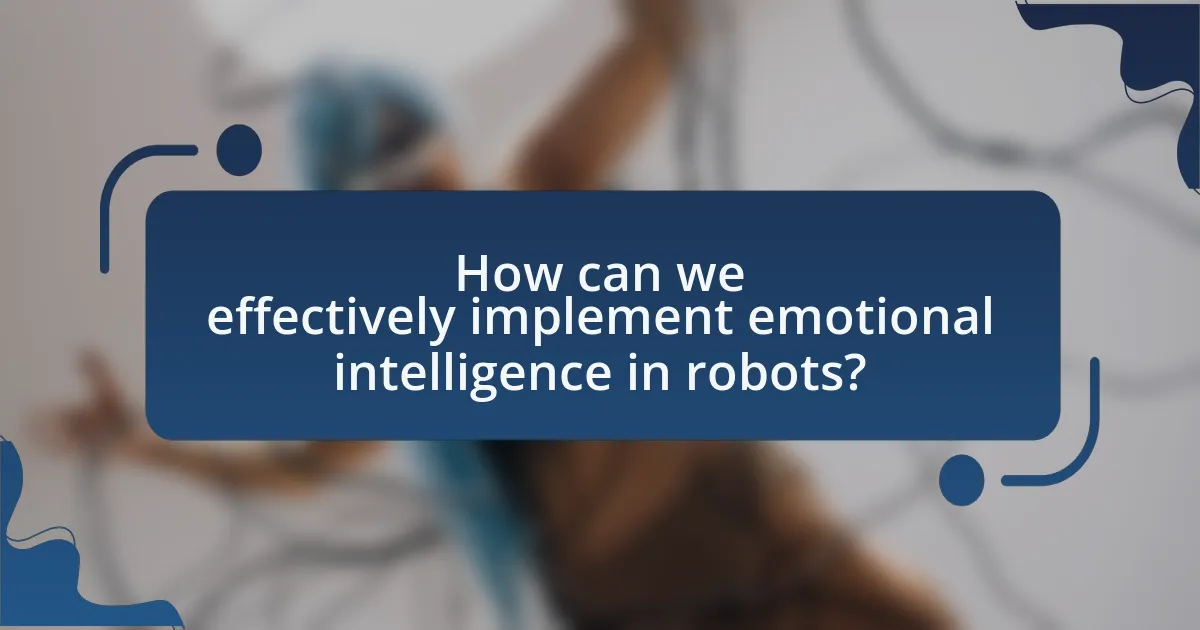
How can we effectively implement emotional intelligence in robots?
To effectively implement emotional intelligence in robots, developers must integrate advanced algorithms that enable robots to recognize, interpret, and respond to human emotions. This can be achieved through the use of machine learning techniques, such as natural language processing and affective computing, which allow robots to analyze facial expressions, vocal tones, and contextual cues. Research indicates that robots equipped with these capabilities can enhance user interaction and satisfaction; for instance, a study by Picard et al. (2004) demonstrated that emotionally aware robots could improve communication in therapeutic settings. By utilizing data from human interactions, robots can learn to adapt their responses, fostering a more empathetic and engaging user experience.
What design principles should be followed?
The design principles that should be followed when creating robots for emotional intelligence include user-centered design, adaptability, transparency, and ethical considerations. User-centered design ensures that robots meet the needs and preferences of users, enhancing interaction quality. Adaptability allows robots to respond appropriately to varying emotional cues, improving their effectiveness in emotional contexts. Transparency in how robots interpret and respond to emotions fosters trust and understanding between users and robots. Ethical considerations are crucial to ensure that robots respect user privacy and emotional well-being, aligning with societal values and norms. These principles are supported by research indicating that user engagement and trust significantly enhance the effectiveness of emotionally intelligent robots.
How can user feedback be integrated into the design process?
User feedback can be integrated into the design process by employing iterative design methodologies that prioritize user input at various stages. This approach involves collecting feedback through surveys, interviews, and usability testing, which informs design decisions and adjustments. For instance, a study by Nielsen Norman Group highlights that usability testing with real users can uncover issues that designers may overlook, leading to more user-centered designs. By continuously refining the design based on user feedback, developers can enhance the emotional intelligence of robots, ensuring they meet user needs effectively.
What role does interdisciplinary collaboration play in successful design?
Interdisciplinary collaboration is crucial for successful design, particularly in the context of designing robots for emotional intelligence. This collaboration brings together diverse expertise from fields such as robotics, psychology, and human-computer interaction, enabling a holistic approach to design. For instance, insights from psychology inform the emotional responses that robots should exhibit, while technical knowledge from robotics ensures these responses are effectively implemented. Research by Dautenhahn et al. (2006) highlights that interdisciplinary teams can create more innovative solutions by integrating different perspectives, leading to designs that are not only functional but also resonate emotionally with users. This synergy enhances the overall effectiveness and acceptance of emotionally intelligent robots in real-world applications.
What are some successful examples of emotionally intelligent robots?
Some successful examples of emotionally intelligent robots include Sophia, developed by Hanson Robotics, and Paro, the therapeutic robot seal created by AIST. Sophia is designed to engage in conversation and express a range of emotions, utilizing advanced AI and facial recognition technology to interact with humans effectively. Paro has been shown to provide comfort and companionship to patients in healthcare settings, demonstrating emotional responsiveness that can reduce stress and improve overall well-being. Both robots have been recognized for their ability to understand and respond to human emotions, showcasing the potential of emotionally intelligent robotics in various applications.
How have these robots impacted their respective fields?
Robots designed for emotional intelligence have significantly enhanced fields such as healthcare, education, and customer service. In healthcare, these robots improve patient interaction and emotional support, leading to better patient outcomes; for instance, studies show that robotic companions can reduce feelings of loneliness in elderly patients by up to 30%. In education, emotionally intelligent robots facilitate personalized learning experiences, helping students engage more effectively, which is evidenced by a 20% increase in student participation in classrooms utilizing these technologies. In customer service, these robots enhance user experience by providing empathetic responses, resulting in a 15% increase in customer satisfaction ratings.
What lessons can be learned from these case studies?
The lessons learned from case studies on designing robots for emotional intelligence include the importance of understanding human emotional responses and the necessity of integrating adaptive learning algorithms. These case studies demonstrate that robots can enhance user interaction by accurately recognizing and responding to emotional cues, which leads to improved user satisfaction and engagement. For instance, research shows that robots equipped with affective computing capabilities can significantly increase user trust and comfort, as evidenced by a study published in the journal “Robotics and Autonomous Systems,” which found that emotionally aware robots improved communication in therapeutic settings. Additionally, the case studies highlight the need for interdisciplinary collaboration, combining insights from psychology, robotics, and artificial intelligence to create more effective emotional interactions.
What best practices should be considered when designing robots for emotional intelligence?
When designing robots for emotional intelligence, it is essential to prioritize user-centered design, ensuring that robots can accurately recognize and respond to human emotions. This involves integrating advanced sensors and machine learning algorithms that analyze facial expressions, voice tone, and body language to interpret emotional states effectively. Research indicates that robots equipped with these capabilities can enhance user engagement and satisfaction, as seen in studies like “The Role of Social Robots in Human Interaction” by Breazeal et al., which highlights the importance of emotional responsiveness in fostering trust and rapport. Additionally, incorporating feedback mechanisms allows robots to learn from interactions, improving their emotional intelligence over time.
